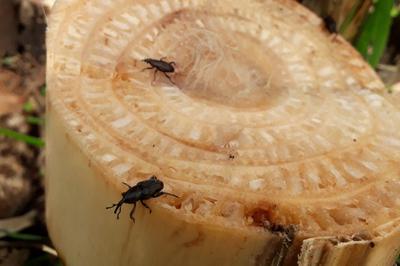Root Borer
Cosmopolites sordidus
Insect
In a Nutshell
- Eggs are laid in groups under litter or in the ground.
- The eggs are hatched after two to three weeks and tunnel downward into the ground, where they feed on the roots of trees and shrubs.
- Plants show stunted growth and can be blown over during adverse weather.
Can also be found in
Symptoms
Pale green, withering and floppy foliage may be the first symptoms in infested banana plants. Feeding holes or excrement may be observed first on the older leaf sheaths or on the lower parts of the stems. The larvae bore tunnels in stems and roots, sometimes across their entire length. In severely infested tissues, rotting occurs through fungal decay, visible as a black discoloration. The feeding damage and the colonization by opportunistic pathogens interferes with water and nutrient transport, causing leaves to dry up and die prematurely. Young plants fail to develop and older ones show stunted growth. In severe cases, affected plants can be blown over during adverse weather. The size and number of bunches is also considerably decreased.
Recommendations

Organic Control
In the past, myriad of predators have been used with relative success to control the pest, among others some species of ants and beetles. The most successful of these predators are the beetles Plaesius javanus and Dactylosternus hydrophiloides. Hot water treatments of suckers (at 43°C for 3 h or 54°C for 20 min) before planting is also effective. Suckers should then be planted in a new plantation as soon as possible. Dipping suckers in a 20% neem seed solution (Azadirachta indica) at planting also protects the young plants against the disease.

Chemical Control
Always consider an integrated approach with preventive measures together with biological treatments if available. An effective control root borer populations can be reached with the application of insecticides at the base of the plant. Insecticides of the group of organophosphates (chloryphos, malathion) are also available but these are expensive and can be toxic to the handler and the environment.
What caused it?
The damage to the crop is caused by the insect Cosmopolites sordidus and its larvae. Adults are dark brown to gray black, with shining armor. They are most commonly found at the base of the plant, associated with crop residues, or in leaf sheaths. They are nocturnal and survive without feeding for several months. Females lay white, oval eggs in holes on crop residues in soil or hidden in the leaf sheaths. Egg development does not occur below 12°C. After hatching, young larvae bore tunnels in the roots or in stem tissues, weakening the plants and sometimes causing them to fall over. Opportunistic pathogens use the wounds caused by the root borer to infect the plant. The spread of the pest from one plantation to another occurs mainly via infested planting material.
Preventive Measures
- Do not transport banana planting material between different regions.
- Use planting material from certified sources.
- Use resistant varieties if available.
- Stimulate beneficial insect predators like ants and beetles.
- Cut some stem or root logs in two parts and bury them below the soil surface to attract females (The eggs laid there eventually die).
- In case of high infestation, dig out and remove all plant residues, trash, and other materials in which weevils may breed.
- Use a fallow with cover crops of a minimum two years before planting again.
- Crop rotation is recommended in fields infested with this pest.



